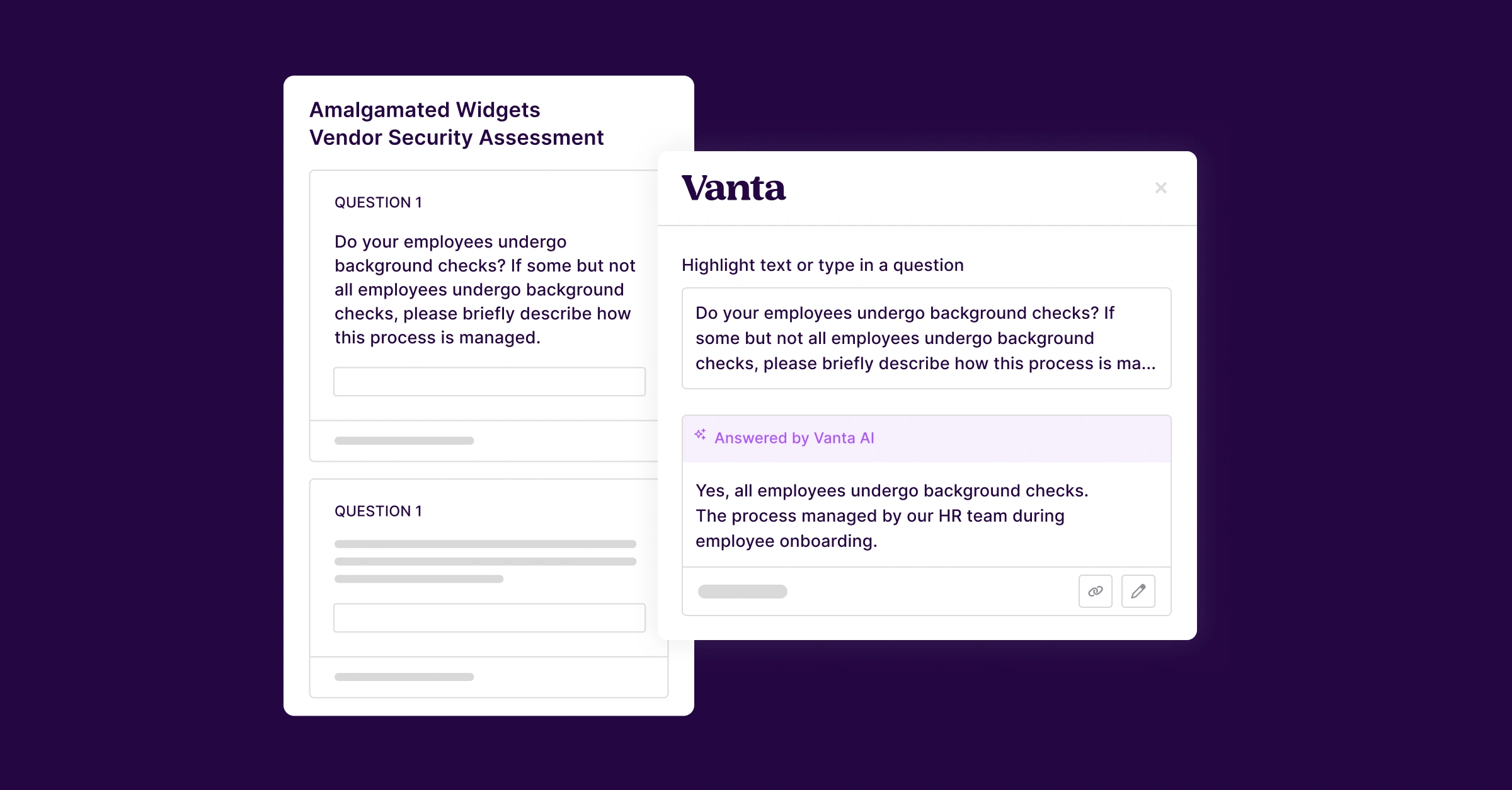Share this article

How we fixed a session race condition at Vanta
Accelerating security solutions for small businesses Tagore offers strategic services to small businesses. | A partnership that can scale Tagore prioritized finding a managed compliance partner with an established product, dedicated support team, and rapid release rate. | Standing out from competitors Tagore's partnership with Vanta enhances its strategic focus and deepens client value, creating differentiation in a competitive market. |
Vanta provides audit firms and managed service providers (MSPs) with a dedicated console that allows them to oversee their clients and deliver audit and management services effectively. Partners work with their customers within their Vanta instances, conducting audits or helping them set up and manage their security and compliance program. To access their customers seamlessly, our authentication flow allows users to safely work across their customers’ Vanta instances without having to manually reauthenticate each time.
Since our partners provide additional services to our customers, it’s imperative that they have uninterrupted access to their clients’ Vanta instances. So, when we received reports from our partners that they were unexpectedly logged out throughout the day, we knew that fixing this issue was a top priority.
When partners with substantial initial page load data attempted to access their customers’ Vanta instances, they would experience unexpected logouts. The high volume of concurrent network requests, combined with potential CPU or network limitations, triggered these forced logouts. The difference between our small test accounts and partners' data-rich environments initially prevented us from replicating the issue internally. Observing the bug with a partner allowed us to identify the root cause and begin working on a solution.
Uncovering the root cause
With these clues, we had a hunch that something with our session authentication flows was amiss. Looking at our session and authentication code, we found a pull request made that roughly lined up with our first bug report. The change in question updated our custom idle session duration feature, setting rolling: true in our express-session configuration. Enabling rolling: true allowed us to improve our custom middleware, decreasing session store writes by ~20%.
While this change helped improve the performance and reliability of our sessions, it also introduced a subtle race condition when partners attempted to access their client’s Vanta instances.
Our session management flow uses express-session, with user sessions tied to a connect.sid cookie. When a user authenticates or reauthenticates, the server generates a new session, and the response includes a Set-Cookie header to update the client's connect.sid cookie.

Crucially, before we enabled rolling: true, this cookie would be set infrequently, upon user action to access one of their customers (reauthentication) or initial login. Turning on rolling: true changed that. Now, every server request reset the session cookie via the Set-Cookie header—even when the session hadn't actually changed.
Here's where things got tricky: during a reauthentication, multiple in-flight requests could overlap. Some older requests would still be pending when the reauthentication completed and the new session was issued. When those older requests finally returned, they would overwrite the browser's connect.sid with an outdated session ID.
As a result, the client would unknowingly use a stale session cookie, causing future requests to fail authentication and forcing the user back to the login page. With this understanding, we turned our focus to fixing the race condition.

Investigating cookie management
We brainstormed how we could prevent the race condition of server requests overwriting the new cookie value from the reauthentication flow with the old cookie value from a parallel or in-flight request. We first started with looking at ApolloClient, the library our React app uses to manage state when communicating with the server.
ApolloClient built-in handling
Looking through our codebase, we found that we were already using ApolloClient's stop and clearStore methods in a different part of the app to stop in-flight requests. This initially seemed like a good way to prevent in-flight requests from “completing” and overwriting the new cookie value from the reauthentication flow.
/** New code */
// Cancel any in-flight requests to prevent the new cookie value being overwritten.
client.stop();
await client.clearStore();
/** Existing code */
await reauthenticate(...);
...
However, with further testing, we were able to still hit the race condition if we throttled the network connection resulting in requests made before reauthentication to return right after the reauthentication, overwriting the cookie. This was confusing as the ApolloClient methods seemed to not be having the intended effect.
We dove into the ApolloClient source code to verify our understanding of stop and clearStore. It turned out that the original code that utilized stop and clearStore was actually not doing what we expected. The stop method removes queries from the QueryManager. However, this means that subsequent calls to stop or clearStore to cancel the in-flight requests won't actually tell its listeners to abort the query because they’ve been detached.
With this finding, we removed stop, which would allow clearStore to correctly abort the in-flight requests.
// Do not call `client.stop()` here as it will not abort in-flight requests and subsequent attempts to abort
// Cancel any in-flight requests to prevent the new cookie value being overwritten.
await client.clearStore();
await reauthenticate(...);

We thought the issue was fixed, however we found that we could still reproduce the race condition this time by throttling the CPU. We observed that throttling the CPU caused the React app to render slower and in batches. This meant that the reauthentication flow could be triggered at the same time as other requests, and the request wouldn’t get aborted with the clearStore call causing the cookie to be overwritten.
Essentially, mechanisms that cause network requests to be batched and parallelized could cause this error. Some examples include pages sequentially fetching all list items from a paginated endpoint, pages with polling, and pages powered by lots of network requests especially if the user’s CPU is slow.
Exploring more options
At this point it was clear that we had exhausted all of our low hanging fruit and we needed to invest in a larger fix. We brainstormed and came up with a few ideas:
- Aborting ongoing network requests: Our first idea was to change our client-side request middleware to cancel all in-flight requests during reauthentication but this would have required a significant and risky migration given the extensive observability, monitoring, and feature dependencies built on top of the existing middleware.
- Server-side adjustments: Another idea was to tweak session behavior server-side. However, there was no clean way to manage sessions at the level we needed without risking breaking the guarantees provided by express-session. We decided it was unsafe to tamper with these internals for such a nuanced edge case.
- Reverting the rolling sessions change: Reverting the rolling sessions change was considered but deemed undesirable due to known database performance issues and conflict with the recommended approach for short session timeouts and long-term session management goals. The priority was to find a solution that resolves the immediate problem while progressing towards the desired future state.
- Doing nothing: Doing nothing was another considered option. This involved advising customers to only use Vanta on a single browser tab as a temporary workaround. This would have persisted until a separate, long-term project resolved the core authentication problem within a few months. However, this approach would degrade the experience for power users, negatively impacting their productivity and causing frustration.
- Isolating the authentications: Our final idea was to prevent other network requests from being fired by creating dedicated client routes for reauthentication where we would have full control over what network requests were made. Reauthentication flows would be guaranteed to cancel any in-flight requests by navigating to the dedicated route with no other network requests.
We liked this final approach over the others as they had more associated risks and technical debt that we’d take on. The isolating of the reauthentication flows was also relatively straight forward, and with our future plans to fully fix our reauthentication flow, easier to undo.
Implementing the new plan
Previously, the user would access a customer by performing an interaction that would initiate the reauthentication flow by sending a network request to the server. With our plan, instead of having the button kick off the network request, we reworked the button click to initiate a new flow:
- Use window.location.replace to navigate to a dedicated client-side route for reauthentication.
- On this route, only fire two network requests:
- One to identify the user
- One to reauthenticate and establish a fresh session

Navigating via window.location.replace (rather than React Router) was crucial—it canceled all in-flight requests that might have returned old session cookies. This ensured the browser only ever received a clean session state after reauthentication.
After shipping the change, we could see that users were now using the new reauthentication flow as users were now landing on the new /redirect/:domainId route. We then reached out to the customers who originally reported the issue and they confirmed that they were not experiencing the issue anymore.

Key learnings
- Get to the root cause: Initial symptoms were misleading; understanding the interplay between cookies, network timing, and Express was essential
- Evaluate all options carefully: We considered client-side, server-side, and library upgrades before choosing the lowest-risk solution
- Simple is better: A targeted client-side isolation was far less risky than reworking session management or Apollo internals
- Bias for action: We solved the customer pain point quickly without taking on significant tech debt
If solving tricky real-world engineering challenges like this sounds exciting, we're hiring! Check out open roles at Vanta.





FEATURED VANTA RESOURCE
The ultimate guide to scaling your compliance program
Learn how to scale, manage, and optimize alongside your business goals.























.png)


.svg)
.svg)
.png)
.png)
.png)